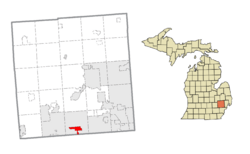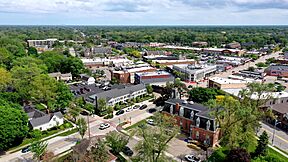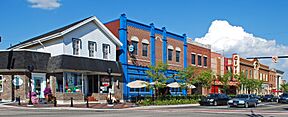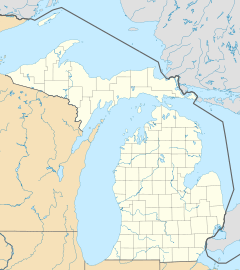Farmington, Michigan facts for kids
Quick facts for kids
Farmington, Michigan
|
|
|---|---|
| City of Farmington | |
|
|
|

Location within Oakland County
|
|
| Country | United States |
| State | Michigan |
| County | Oakland |
| Founded | 1824 |
| Incorporated | 1867 (village) 1926 (city) |
| Government | |
| • Type | Council–manager |
| Area | |
| • City | 2.66 sq mi (6.90 km2) |
| • Land | 2.66 sq mi (6.90 km2) |
| • Water | 0.00 sq mi (0.00 km2) |
| Elevation | 751 ft (229 m) |
| Population
(2020)
|
|
| • City | 11,597 |
| • Density | 4,354.86/sq mi (1,681.33/km2) |
| • Metro | 4,296,250 (Metro Detroit) |
| Time zone | UTC-5 (EST) |
| • Summer (DST) | UTC-4 (EDT) |
| ZIP code(s) |
48332, 48335, 48336
|
| Area code(s) | 248 |
| FIPS code | 26-27380 |
| GNIS feature ID | 0625837 |
Farmington is a city in Michigan, a state in the United States. It's located in Oakland County. Farmington is a suburb of Detroit, about 20 miles (32 km) away from downtown. The larger city of Farmington Hills surrounds it on most sides.
In 2020, about 11,594 people lived in Farmington. The city is famous for its historic downtown area. You can also see many beautiful Victorian-style homes there. Farmington is also known for having one of Michigan's best public school systems, Farmington Public Schools.
Contents
History of Farmington
Farmington was an important place for Native Americans long ago. Three of their trails, the Orchard Lake Trail, the Grand River Trail, and the Shiawassee Trail, passed through this area.
Founding the City
Arthur Power founded Farmington in 1824. He came from New York, just like many other early settlers in Oakland County. Power and the people who joined him were Quakers. Because of this, the town was first called Quakertown.
In 1826, the name Farmington was officially chosen. This was because Farmington was the name of Arthur Power's hometown in New York.
Farmington vs. Farmington Hills
Sometimes, people get Farmington and Farmington Hills confused. Farmington is a smaller city, about 2.7 square miles (6.9 km2), that was formed in the early 1800s. Farmington Hills is a much larger city, about 33.3 square miles (86.2 km2), that surrounds Farmington. Farmington Hills used to be called Farmington Township until 1973.
Historic District and Modern Changes
In 1976, a part of Farmington was recognized as the Farmington Historic District. This means it's a special area with important historical buildings.
Since 2009, downtown Farmington has undergone many improvements. Many buildings on Grand River Avenue have been updated or rebuilt. New brick sidewalks, the Farmington Pavilion, and better lighting and landscaping have also been added.
Farmington has been recognized as a great place to live. In 2007, CNNMoney.com ranked Farmington as number 55 in its "Best Places to Live" survey. In 2013, it moved up to 27th place. This was partly because the city spent nearly $3 million on more renovations and development.
Geography of Farmington
Farmington is a city that covers about 2.66 square miles (6.9 km2). According to the United States Census Bureau, all of this area is land. There are no large bodies of water within the city limits.
Population and People
| Historical population | |||
|---|---|---|---|
| Census | Pop. | %± | |
| 1880 | 377 | — | |
| 1890 | 320 | −15.1% | |
| 1900 | 530 | 65.6% | |
| 1910 | 564 | 6.4% | |
| 1920 | 853 | 51.2% | |
| 1930 | 1,243 | 45.7% | |
| 1940 | 1,510 | 21.5% | |
| 1950 | 2,325 | 54.0% | |
| 1960 | 6,881 | 196.0% | |
| 1970 | 10,329 | 50.1% | |
| 1980 | 11,022 | 6.7% | |
| 1990 | 10,132 | −8.1% | |
| 2000 | 10,423 | 2.9% | |
| 2010 | 10,372 | −0.5% | |
| 2020 | 11,597 | 11.8% | |
| U.S. Decennial Census | |||
Population in 2010
In 2010, there were 10,372 people living in Farmington. These people lived in 4,624 households, and 2,735 of these were families. The city had about 3,899 people per square mile (1,505 per km2).
Most of the people in Farmington were White (71.5%). There were also significant numbers of African American (11.4%) and Asian (13.9%) residents. About 2.1% of the population identified as Hispanic or Latino.
About 28% of households had children under 18 living with them. The average household had 2.22 people. The median age in the city was 39.5 years.
Education in Farmington
Farmington is part of the Farmington Public Schools district. Some of the district's schools are located right in Farmington. These include Farmington High School and Longacre Elementary School. The main offices for the school district are also in Farmington.
Most of the other schools in the district are in the neighboring city of Farmington Hills. Our Lady of Sorrows Catholic School, which opened in 1935, is also located in Farmington.
City Library
The Farmington Community Library serves the city of Farmington. It has a branch in downtown Farmington. The library's main location is in Farmington Hills.
Interesting Places to Visit
The old Farmington Winery building is a notable spot. It's on Grand River Avenue, just west of Orchard Lake Road. During the Halloween season, this building is transformed into the "Haunted Winery," which is a popular attraction.
Local News and Media
People in Farmington can read several newspapers to stay informed. Besides the larger regional newspapers like The Detroit News and the Detroit Free Press, there are local community newspapers.
The Farmington Observer is published twice a week. The Farmington Press comes out once a week. For news about all of Oakland County, residents can read The Oakland Press.
Notable People from Farmington
Many interesting people have lived in Farmington, including:
- Rex Cawley – A gold medalist in the 1964 Tokyo Olympics.
- Michael Fougere – A former mayor of Regina, Saskatchewan, Canada.
- Devin Funchess – A wide receiver who played for the Carolina Panthers in the NFL.
- Mickey Harris – A baseball pitcher.
- Bob Johnson – An ice hockey goaltender.
- Brent Johnson – An ice hockey player who played for the Pittsburgh Penguins.
- Khalid Kareem – A defensive end for the Cincinnati Bengals in the NFL.
- Robert Patrick – A well-known Hollywood actor.
- Drew Stanton – A former NFL quarterback.
- Mike Vellucci – A head coach for the Charlotte Checkers ice hockey team.
- Garlin Gilchrist II – The current Lieutenant Governor of Michigan.
See also
 In Spanish: Farmington (Míchigan) para niños
In Spanish: Farmington (Míchigan) para niños





